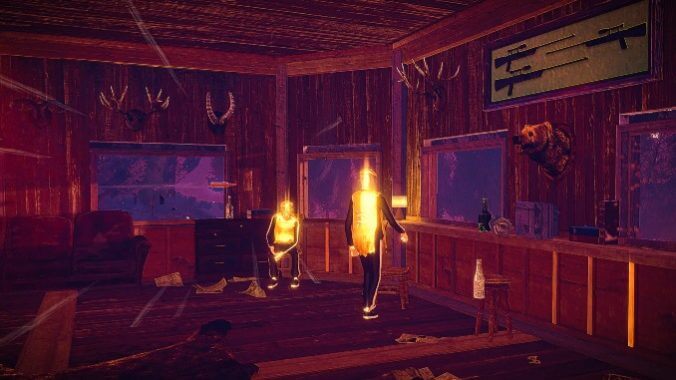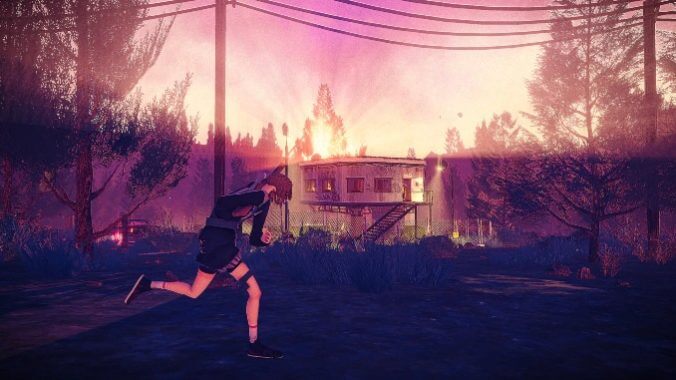Children of the Sun Is A Blood-Soaked Puzzle Game About Lining Up Shots and Taking Revenge

There’s a lot to take in with Children of the Sun, a solo dev project from René Rother and publisher Devolver Digital, but the first thing that jumps out are its feverish bad vibes. Surrounded by a purple haze, The Girl takes aim at an unsuspecting cultist and fires her only bullet. Propelled by more than gunpowder, it finds its mark, sweeping the target off their feet as a cartoonish geyser of gore erupts from their skull. However, this projectile hasn’t reached its final destination. The other victims watch in horror as the round emerges from their dead compatriot, leapfrogging across the battlefield and into brains until there’s no one left standing beside the shooter, whose glaring green eyes and serial killer mask imply this isn’t the last hunt.
If it wasn’t clear, this is a nasty, magenta-tinted revenge thriller where you play as a sniper who uses a single bullet to wipe out those who took everything from her. Drawing on other puzzle-action game hybrids, it combines the trigger-pulling thrills of an FPS with the problem-solving of something slightly more cerebral, forcing you to consider each move as you chart a path through gray matter. It’s clever, fun, and grimy as can be, following at least partially in the footsteps of definitive Nasty Boy games like Manhunt or Kane and Lynch. While its relatively short runtime and difficult-to-parse narrative slightly hold it back, altogether, it’s a striking freshman effort that hits the mark.
The core gameplay setup is pretty simple: The Girl’s objective is to kill all the cultists in each level. You can move left or right to set up your shot but are confined to maneuvering within a fixed semi-circle around the area. And as alluded to, the trickiest part is that you only have one round of ammo to wipe out your prey. If you hit a cultist (or a gas tank or a stray bird), time slows down while you line up where your hot lead will fly next, the projectile jumping between targets thanks to the protagonist’s psychic powers until everyone is dead, or you miss and start over from the beginning of the stage.

It’s a straightforward setup that works because it combines the satisfaction of landing shots with slow-mo interludes that provide wiggle room to think through your next move. This constant switching between quick visceral acts and something more deliberate makes Children of the Sun feel in conversation with other stop-and-go action games, such as Superhot or Hotline Miami, which are also about puzzling out the best way to orchestrate great acts of violence. And like those, it’s these moments of cold contemplation that make all the killing a strange mixture of gratifying and offputting, the dissonance between having enough time to stare into the pixelated eyes of your soon-to-be-dead foes contrasting against the glee of all the little audio-visual touches that make it admittedly very fun to blast these dudes.
One of the best details is that as each round leaves the chamber, the camera eagerly follows the projectile, offering a front-row seat for when the next victim is hit with a bullet that arrives with the weight of a freight train. On top of this, when a shot lands, you’re serenaded by a delightful cymbal crash, and when everyone is wiped out, the last enemy drops amidst a blaring mix-amp as spasming yellow text reads “DEAD.” If that didn’t release enough happy brain chemicals, there’s also a combo system where if you chain together hits quickly or perform trickier maneuvers like lining up multi-kills by detonating explosives, you can rack up big score multipliers that propel you up the leaderboard.
As for the puzzling, the main challenge is figuring out how to avoid dead ends so you can string together every kill in one go. Although things start off relatively straightforward, as larger numbers of tough foes are introduced, such as armored enemies, these stages eventually require just the right amount of brainpower. Adding to the complexity are upgrades that give even more control over the bullet: first, you learn how to curve it, then to completely change its trajectory mid-air, and last, to speed it up until it moves so fast it tears the fabric of reality. Each is gated to limitations, like hitting a certain number of enemy weak points to unlock a charge of the ability, adding even more complexity to finding an efficient path.
-

-

-

-

-

-

-

-

-

-

-

-

-

-

-

-

-

-

-

-

-

-

-

-

-

-

-

-

-

-

-

-

-

-

-

-

-

-

-

-









































